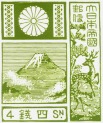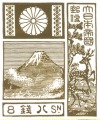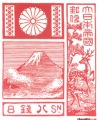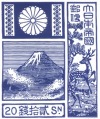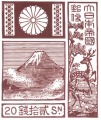Mt. Fuji and Deer
Many postage stamps from Japan feature the mountain that is symbolic for Japan, Fuji-yama. Few have ever shown the deer that are found on the islands, and this is the first. Printed in 1922, and again in 1937, the stamp has a quirky kind of modular design that was not often used in stamp design.
There are four separate blocks that are assembled into the final design. The upper left shows the chrysanthemum motif emblematic of the emperor found on all stamps from Japan until the end of World War II when the divinity of the emperor was repudiated. The central left block shows Mt. Fuji emerging from a mantle of clouds. The bottom left is a small block designating the value for postage and letters designating the stamps as Japanese. The 4 sen was printed in green or orange, the 8 sen in rose or olive green or bister, and the 20 sen in blue, deep blue, or brown violet.
The entire right block shows a pair of deer including an adult and a fawn. Unlike most American deer, the dappling on the back persists into adulthood on the Japanese deer (Cervus sika). There is a stylized pine tree to the left, and strange circular and spiral-like forms on the ground that must be foliage. The scene seems quite bizarre to a modern viewer, perhaps even a little psychedelic. Maybe that is why is a favorite of mine.
There are four separate blocks that are assembled into the final design. The upper left shows the chrysanthemum motif emblematic of the emperor found on all stamps from Japan until the end of World War II when the divinity of the emperor was repudiated. The central left block shows Mt. Fuji emerging from a mantle of clouds. The bottom left is a small block designating the value for postage and letters designating the stamps as Japanese. The 4 sen was printed in green or orange, the 8 sen in rose or olive green or bister, and the 20 sen in blue, deep blue, or brown violet.
The entire right block shows a pair of deer including an adult and a fawn. Unlike most American deer, the dappling on the back persists into adulthood on the Japanese deer (Cervus sika). There is a stylized pine tree to the left, and strange circular and spiral-like forms on the ground that must be foliage. The scene seems quite bizarre to a modern viewer, perhaps even a little psychedelic. Maybe that is why is a favorite of mine.
